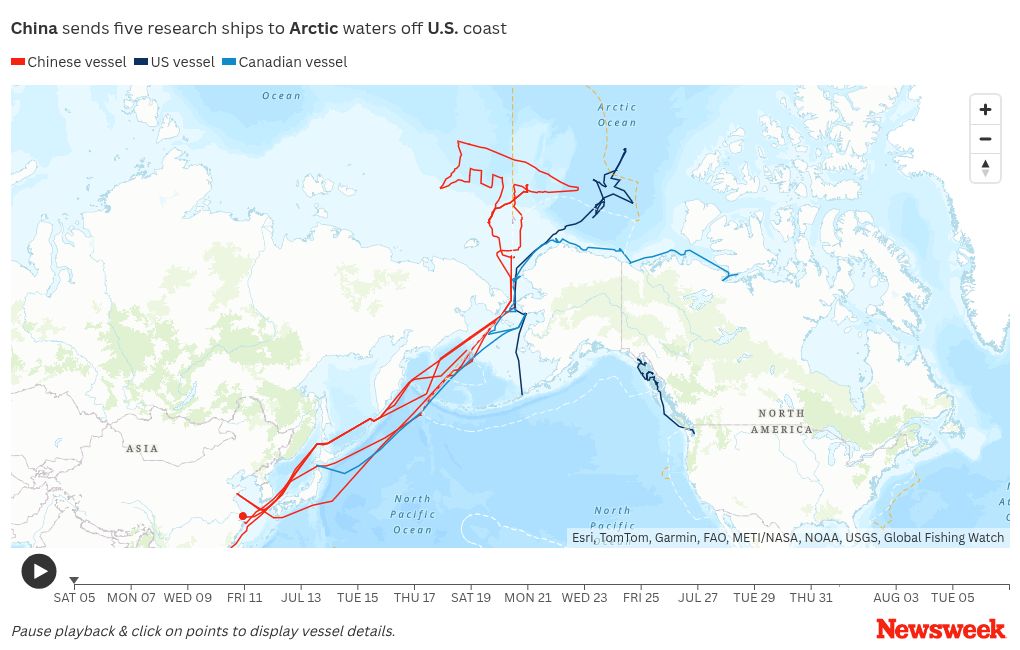China has simultaneously deployed five research vessels in or near the Arctic around Alaska recently, according to the U.S. Coast Guard, which is currently monitoring their movements, telling Newsweek the service “remains ready to respond to adversaries operating in and around Alaskan and U.S. Arctic waters.”
Newsweek has contacted the Chinese Foreign Ministry for further comment via email.
Why It Matters
China has long asserted itself as a “near-Arctic state” and an important stakeholder in Arctic affairs. It has steadily expanded its presence in the region—surrounded by NATO member states and Russia—including deploying three research vessels simultaneously last summer.
The U.S. has been alarmed by China’s presence in the Arctic—as well as its cooperation with Russia—and the Pentagon has called for an increased military presence, enhanced intelligence capabilities, and greater cooperation with U.S. allies to address Chinese activity.
What To Know
Using open-source ship tracking data, a Newsweek map shows the voyages of Chinese vessels from their home coastline to waters near Alaska, while two United States and one Canadian icebreaker have been operating in the same region since late July.
“China has always conducted normal maritime activities in relevant waters in accordance with international law,” China’s Embassy in Washington, D.C., previously told Newsweek.

Maritime news outlet gCaptain was the first to report what it described as an “unprecedented Arctic move” by Chinese ships, while the U.S. Coast Guard operated only one icebreaker, USCGC Healy, in the Arctic to conduct a mission reinforcing U.S. presence in the region.
In a press release on Friday, the U.S. Coast Guard confirmed that it detected and responded to two Chinese research vessels—the Ji Di and the Zhong Shan Da Xue Ji Di—operating in the U.S. Arctic on August 5 and 6 in the Bering Sea and the Bering Strait near Alaska.
The Bering Sea and the Bering Strait lie between the Russian far east region to the west and Alaska to the east, serving as a gateway from the North Pacific Ocean to the Arctic Ocean.
On July 25, the U.S. Coast Guard monitored another Chinese ship—the Xue Long 2—on the U.S. Extended Continental Shelf, an area that extends beyond 230 miles from Alaska’s coastline. As of August 6, the ship remained in the area, according to Newsweek‘s map.
“The presence of these vessels is consistent with a three-year trend of increased activity from Chinese research vessels operating in the U.S. Arctic,” the U.S. Coast Guard said in the press release.
While the U.S. Coast Guard did not identify the remaining two Chinese vessels operating near Alaska, gCaptain reported them to be the Shen Hai Yi Hao and the Tan Suo San Hao.
As of August 6, the Shen Hai Yi Hao was tracked operating in proximity to the Xue Long 2, while the Tan Suo San Hao was heading toward the Bering Strait, Newsweek‘s map shows.
At the same time, the Healy was sailing south of the U.S. Extended Continental Shelf, and it has not been in visual contact with Chinese vessels, the U.S. Coast Guard told Newsweek.
“The Coast Guard remains ready to respond to adversaries operating in and around Alaskan and U.S. Arctic waters,” the service said in a written response to Newsweek on Friday.
According to Chinese authorities, the Xue Long 2 is the country’s first domestically made icebreaker, designed specifically for conducting polar research. The Ji Di is classified as a new-generation icebreaking research vessel, delivered just a little over a year ago.
The Zhong Shan Da Xue Ji Di is an icebreaker operated by Sun Yat-sen University in China.
The Shen Hai Yi Hao, also known as the Deep Sea No. 1, is a scientific expedition vessel specially designed to serve as the mothership for a manned submersible, the Jiaolong.
The Tan Suo San Hao—or the Exploration No. 3—is China’s first scientific research ship designed for global deep-sea exploration and capable of operating in polar regions.
Meanwhile, USCGC Storis, the first polar icebreaker acquired by the U.S. Coast Guard in over 25 years, was commissioned in Juneau, Alaska, on Sunday. Its acquisition is part of the Coast Guard’s efforts to ensure access to the polar regions and protect U.S. sovereignty.
In addition to U.S. and Chinese vessels, the Canadian Coast Guard vessel CCGS Sir Wilfrid Laurier was tracked sailing along the northern coast of Alaska and Canada eastward as of August 6. It was deployed for icebreaking and scientific support in the Western Arctic.
What People Are Saying
The U.S. Coast Guard said in a press release on Friday: “The Coast Guard Arctic District works in conjunction with international partners, U.S. Northern Command, and Alaskan Command to constantly monitor the activity of foreign vessels operating near U.S. sovereign waters and the extended outer continental shelf to ensure homeland security, homeland defense, and compliance with U.S. and international law.”
China’s Embassy in Washington, D.C., previously told Newsweek: “China has always conducted normal maritime activities in relevant waters in accordance with international law, including the United Nations Convention on the Law of the Sea. We hope the parties concerned will view this matter in a proper manner, without undue suspicion or groundless speculation.”
What Happens Next
It remains to be seen how long Chinese ships will operate in the Arctic near Alaska. The U.S. Coast Guard said its responses are aimed at countering malign activities, defending sovereign interests, and promoting maritime conduct consistent with international law and norms.
The post Map Shows Where Chinese Ships Have Been Detected off Alaska appeared first on Newsweek.




